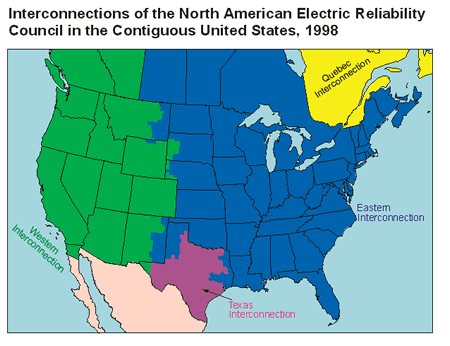Here are some examples of the high
voltage power lines that criss-cross North America.
The North American bulk power system has evolved into four
major networks (power grids), which also include smaller groupings or power
pools. The major networks consist of extra-high-voltage connections between
individual utilities designed to permit the transfer of electrical energy
from one part of the network to another. These transfers are restricted, on
occasion, because of a lack of contractual arrangements or because of inadequate
transmission capability.
The four networks are:
- the Eastern Interconnected System, consisting of
the eastern two-thirds of the United States and Canada;
- the Western Interconnected System, consisting primarily
of the Southwest and areas west of the Rocky Mountains;
- the Texas Interconnected System, consisting mainly
of Texas; and
- the Quebec Interconnected System, consisting of
Quebec, Newfoundland and Labrador.

Texas is not interconnected with the other networks (except
by certain direct current lines). The other three networks have limited interconnections
to each other. Both the Western and the Texas Interconnect are linked with
different parts of Mexico. The Eastern and Western Interconnects are completely
integrated with most of Canada or have links to the Quebec Province power
grid. Virtually all U.S. utilities are interconnected with at least one other
utility by these three major grids. The exceptions are in Alaska and Hawaii.
The interconnected utilities within each power grid coordinate operations
and buy and sell power among themselves.
Why aren’t they all connected? Just like many other
slowly evolving standards, by the time we realized it would be worthwhile
to cover the entire continent with electrical service, too many different
variations had been built. The bottom line is that the ‘flavor’
the electricity in each system is not compatible with that of its neighbors.
For example, the electricity in Quebec is out of phase with that in the Eastern
system – to convert from one to the other, you have to convert it first
from alternating current (AC) into direct current (DC), and then back into
alternating current in the proper phase. In the process, you lose some
of the power, making it an expensive conversion.
But converting electricity is an integral part of the entire
transmission process. Electricity is commonly generated at relatively
low voltages, stepped-up to higher voltages for transmission, and then stepped-down
as it nears its destination. Let’s take a look at the lower voltage
stages of the transmission process. |